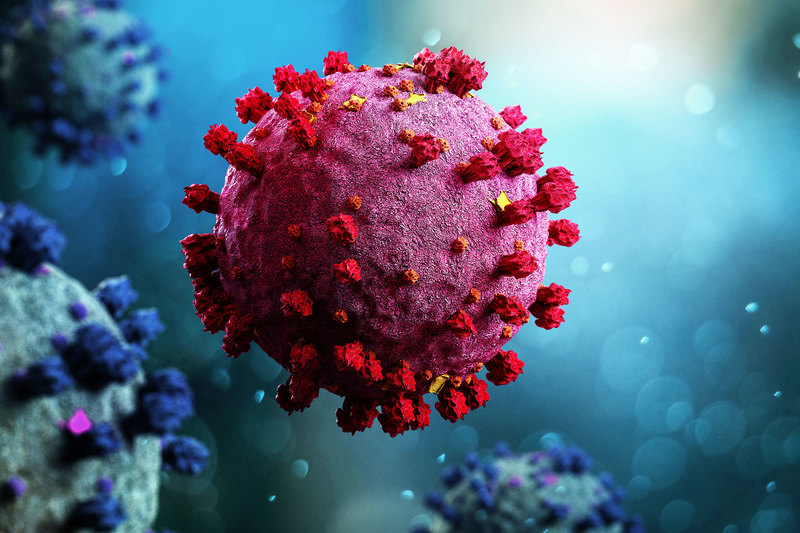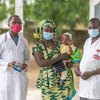COVID-19 third surge: ‘Fraught with problems’
18 March 2021 | Story Niémah Davids. Photo Adobe Stock. Read time 5 min.
As a third wave of COVID-19 infections looms, the University of Cape Town’s (UCT) Professor Marc Mendelson shared some lessons scientists learned during the second wave. He also sketched a picture of the anticipated third surge and offered some tips and advice on how to prepare.
Professor Mendelson is the head of the Division of Infectious Diseases and HIV Medicine at Groote Schuur Hospital. He is the immediate past president of the International Society for Infectious Diseases, and the past president of the Federation of Infectious Diseases Societies of Southern Africa.
Niémah Davids (ND): The second wave reportedly eclipsed the first wave. Tell us why.
Marc Mendelson (MM): The increased intensity of transmission during the second wave occurred as a result of the new variant (501Y.V2), which strengthened the binding of the virus to its receptor on our cells. This resulted in an increased amount of virus being produced and transmitted. At the same time, a number of super-spreader events occurred at social gatherings, compounding transmission of the more infectious virus, leading to a larger peak in the second wave.
ND: With the vaccine roll-out now under way in the country, could this delay the arrival of the third wave somewhat?
MM: At the current rate of the vaccine roll-out almost certainly not. There are never watertight answers when dealing with this pandemic, but to get to population immunity through natural infection plus vaccination-induced immunity will require that millions of the population be vaccinated in a relatively short time frame.
ND: What are scientists’ predictions of what the third wave will look like?
MM: Predicting the third wave, I’d have to say – fraught with problems. There are multiple factors that may come into play, many of which could impact the resulting force of infection. This includes further mutations in the virus, the speed of the vaccination roll-out programme, non-compliance with public health interventions, and the possibility of other unforeseen drivers that we are yet to learn about.
“The only way of reducing the likelihood of another clinically relevant variant coming out of South Africa is to reduce transmission and boost immunity by rolling out vaccines fast.”
ND: What are the chances of new variants cropping up during the third wave and posing greater risks?
MM: Further mutations will occur, but whether they give the virus an evolutionary advantage is yet to be seen. The only way of reducing the likelihood of another clinically relevant variant coming out of South Africa is to reduce transmission and boost immunity by rolling out vaccines fast, so that in addition to achieving natural immunity, induced by people getting infected, the amount of new virus produced will drop to very low levels. If a new variant does not occur this time round, then we should see a less impactful third wave.
In truth, however, with the current tools in our box, we won’t eradicate SARS-CoV-2. What we will probably move to is better control of the virus, in the same way that we control influenza and other respiratory virus infections.
ND: What are some of the lessons learned during the second wave that should not be repeated?
MM: Maintaining a ban on mass gatherings and closer focus on super-spreader events in poorly ventilated indoor spaces is necessary. The relaxation of these interventions played a significant role in helping to propagate the second wave.
“While international travel continues, we know that importing novel variants of SARS-CoV-2 into South Africa is always going to be possible.”
We also need careful assessment of how healthcare workers were deployed to the COVID-19 frontline. Despite the need to keep as many non-COVID-19 services running at an appropriate level, the whole-of-hospital human resource model that was ultimately achieved in the first wave, but diluted in the second, should be reinstated. This would go a long way to providing the physical and psychosocial support to the relative minority of doctors who bore the brunt of the second wave.
ND: How do we best prepare for the third surge in infections?
MM: While international travel continues, we know that importing novel variants of SARS-CoV-2 into South Africa is always going to be possible. That’s why continuing surveillance for new variants through sequencing virus genomes from people infected with COVID-19, and reacting swiftly to changes in circulation of these variants, is very important.
Then of course vaccinate, vaccinate, vaccinate. And maintain all public health prevention measures – those measures are absolutely critical as we look ahead.
 This work is licensed under a Creative Commons Attribution-NoDerivatives 4.0 International License.
This work is licensed under a Creative Commons Attribution-NoDerivatives 4.0 International License.
Please view the republishing articles page for more information.
Faculty of Health Science News
























